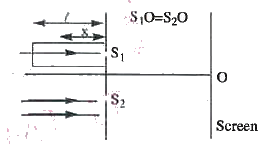In the figure shown , , a parallel beam of light is incident on the plane of the slits of a Young.s double slit experiment. Light incident on the slit S1 passes through a medium of variable refractive index μ=+ax (where .x. is the distnce from teh plane of slits as shown ) upto a distance .l. before falling on S1 . Rest of the space is filled with air .If at .O. minima is formed , then the minimum value of the positive constant a ( in terms of l and wavelength λ in aire is ) is :

λl
λl2
l2λ
None of these
The correct Answer is:B
Topper's Solved these Questions
- BOOK - AAKASH SERIESCHAPTER - WAVE OPTICSEXERCISE - ADDITIONAL PRACTICE EXERCISE (LEVEL - II ) LECTURE SHEET (ADVANCED ) (More Than one correct Type Questions)4videos
WAVE OPTICS
- BOOK - AAKASH SERIESCHAPTER - WAVE OPTICSEXERCISE - ADDITIONAL PRACTICE EXERCISE (LEVEL - II ) LECTURE SHEET (ADVANCED ) (Linked Comprehension Type Questions)3videos
WAVE OPTICS
- BOOK - AAKASH SERIESCHAPTER - WAVE OPTICSEXERCISE - ADDITIONAL PRACTICE EXERCISE (LEVEL - I ) (MAIN) (Straight Objective Type Questions)17videos
WAVE OPTICS
- BOOK - AAKASH SERIESCHAPTER - WAVE MOTION AND SOUNDEXERCISE - PROBLEMS (LEVEL - II)81videos
WAVE MOTION AND SOUND
- BOOK - AAKASH SERIESCHAPTER - WAVESEXERCISE - EXERCISE-III (Doppler effect :)15videos
WAVES
Similar Questions
In figure, parallel beam of light is incident on the plane of the slits of a Young's double-slit experiment. Light incident on the slit S1 passes through a medium of variable refractive index μ=1+ax (where 'x' is the distance from the plane of slits as shown), up to distance 'I' before falling on S1. Rest of the space is filled with air. If at 'O' a minima is formed. then the minimum value of the positive constant a (in terms of l and wavelength λ in air) is
 View Solution
View SolutionIf the width of the slit S in Young's double slit experiment is gradually increased
 View Solution
View Solution
Knowledge Check
- Question 1 - Select One
In figure, parallel beam of light is incident on the plane of the slits of a Young's double-slit experiment. Light incident on the slit S1 passes through a medium of variable refractive index μ=1+ax (where 'x' is the distance from the plane of slits as shown), up to distance 'I' before falling on S1. Rest of the space is filled with air. If at 'O' a minima is formed. then the minimum value of the positive constant a (in terms of l and wavelength λ in air) is
 AλlBλl2Cl2λDnone of these
AλlBλl2Cl2λDnone of these - Question 2 - Select One or More
In YDSE,D=1m,d=4mm and λ=12mm in the figure shown, a parallel beam of light is incident on the plane of the slits of YDSE. Light incident on the slit s1, passes through a medium of variable refractive index μ=(2x+1) (where x is the distance from the plane of slits in mm) up to a distance l=1mm before falling on s1. Rest of the space filled with air. Then choose the correct option (s):
 APosition of central brigh fringe is at a distanc y=1√3m above the central lineBPosition of central bright fringe is at a distance y=12m above the central lineCNumber of maxima obtaining on the screening is 7DNumber of maxima obtaining on the screening is 8
APosition of central brigh fringe is at a distanc y=1√3m above the central lineBPosition of central bright fringe is at a distance y=12m above the central lineCNumber of maxima obtaining on the screening is 7DNumber of maxima obtaining on the screening is 8 - Question 3 - Select One or More
If white light is used in a Young's double slit experiment,
Abright white fringe is formed at the centre of the screenBfringes of different colours are observed clearly only in the first orderCthe first -order violet fringes are closer to the centre of the screen than the first -order red fringesDthe first -order red fringes are closer to the centre of the screen than the first -order violet fringes
A Young's double slit experiment is performed with white light.
View SolutionA Young's double slit experiment is performed with white light, then
View SolutionA Young's double slit experiment is performed with white light.
View SolutionA Young's double slit experiment is performed with white light, then
View SolutionTwo different color beams (yellow and blue) from a point source are incident on both slits of a Young's double-slit experiment setup
View Solution

